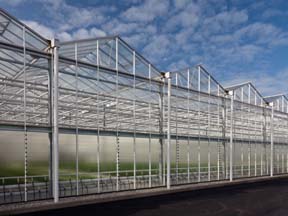Community Aquaponics is the HOT NEW TREND
– by Colle and Phyllis Davis
The impact of a single community aquaponics system is much larger than the excellent ROI (Return on Investment) and high monthly income. The impact of multiple units has a profound effect on virtually every aspect of a community.
 10,000 Sq ft Portable Farms Aquaponics System Commercial Farm Installed in Botswana, Africa
10,000 Sq ft Portable Farms Aquaponics System Commercial Farm Installed in Botswana, Africa
Commercial and community aquaponics systems have now proven themselves over the last two decades and are becoming more effective and efficient as the technology improves. Many people are contributing to the movement and it now appears that community aquaponics has finally arrived as a viable alternative to the easily disrupted food supply and the huge increase in the demand for locally grown, pesticide free food.
For investors looking for an ROI in the two to four year range, a construction company looking for a new arena to expand into over the next decade or two or even a Ministry of Agriculture or an NGO wanting to improve the lives of local people, community aquaponics is a viable option to address their desired outcomes to provide food and work for local people.
The large community installations employ local people on both a temporary (building the systems) and permanent basis (operating, harvesting and planting) and contribute to the local economy. The initial markets are necessarily local markets; resort hotels, high-end restaurants, foodies and specialty markets catering to the wealthy. Within the next few years, community aquaponics systems will contribute to local food supplies on a much broader scale (supermarkets and institutional growing for schools and prisons), but initially they may only contribute to the local economy through job creation.
For instance: An investor group planning to install a commercial (10,000 sq ft – 1/4 acre, 1,000m2) Portable Farms® Aquaponics Systems next to a restaurant in a major US city. Here is what they are planning to accomplish with their very first installation:
Showcase the use of aquaponics as a LOCAL FOOD SOURCE
Deliver locally grown, pesticide free vegetables to their customers not treated with chemicals
Place locally grown fresh-water healthy fish on the menu that were not treated with chemicals or any kind
Reduce transportation costs for most vegetables to ZERO
Serve food that was harvested on the DAY it was meant to be harvested which enhances both the flavor and the nutritional content of the food
Dramatically reduces their carbon footprint
Reduces storage costs because the food is harvested as needed
Reduces prep time because the crops are harvested only as needed
Supply their patrons with the excess production at regular store prices.
Plus the investor group will also reap these benefits:
Realize an ROI of two to four years
Net-net income for 1/4 acre is approximately US$100,000 or more depending on restaurant margins and the selection of crops you grow and sell to them
Become their own supplier for many of the vegetables they now purchase through wholesalers
Have the marketing lead to themselves in their niche for at least two years
Become local spokespersons for using local suppliers and growers
Offers owners ‘bragging rights’ to attract news coverage in the media. Also offers a ‘hook’ for advertising and articles about their aquaponics system to talk about on their website to boast the use of locally grown organic food that was planted, raised and harvested onsite or locally. This alone is worth its price of investment. Word travels fast and people will drive for miles to experience an innovative approach in dining and shopping.
To have the opportunity to invest in anything that has an ROI of less than five years is very tempting and when the investment comes with all of the above benefits, the long term impact for both the investor and the community continues to grow.
 Multiple installations add several more benefits to the equation.
Multiple installations add several more benefits to the equation.
The impact on local employment grows in direct proportion to each new installation
The ancillary services to support the aquaponics installations creates jobs and even new businesses
Tax revenue increases to better serve the community’s needs
A stabilized workforce is more resilient to economic disruptions
The less a community depends on imported energy and food, the more stable the community
Eventually, a surplus may be developed and shipping to other areas
The area could even become a net exporter of food.



7 comments
Skip to comment form
I’m interested in greenhouse farming how much the total production cost
Author
There are many variables regarding cost for greenhouse farming.
1) First of all, how large is your greenhouse footprint? 2) How many people do you want to feed? 3) Are you growing commercially or for your family? What climate are you planning to grow in? Hot? Cold? Moderate/mild?
Colle and Phyllis Davis
What communities could benefit the most from these systems and provide families with healthy meals for their children?
Who would help build the system?
Where in the community would the system go?
What type of crops and how many would be grown in the system?
Author
Our systems are in 25 countries throughout the world. We offer an online course that teaches the users to build and operate the systems. Please visit our website to see the crops our systems will grow. https://portablefarms.com/what-you-can-grow/
Author
Adam,
Why are you asking us these questions? We have had hundreds of ‘community groups’ approach us to address their specific situation. Hard fact. NONE of the community projects have been successful. They fight over the exact questions you are asking. We do not have the answers.
Colle
The large commercial installations employ local people on both a temporary (building the systems) and permanent basis (operating, harvesting and planting) and contribute to the local economy. The initial markets are not necessarily local markets; instead, their best customers now are resort hotels, high-end restaurants and specialty markets catering to the wealthy. Within the next few years, commercial aquaponics systems will contribute to local food supplies on a much broader scale (supermarkets and institutional growing for schools and prisons), but initially they may only contribute to the local economy through job creation.
Author
Janet,
Well stated. Thank you.
Colle Davis – Inventor